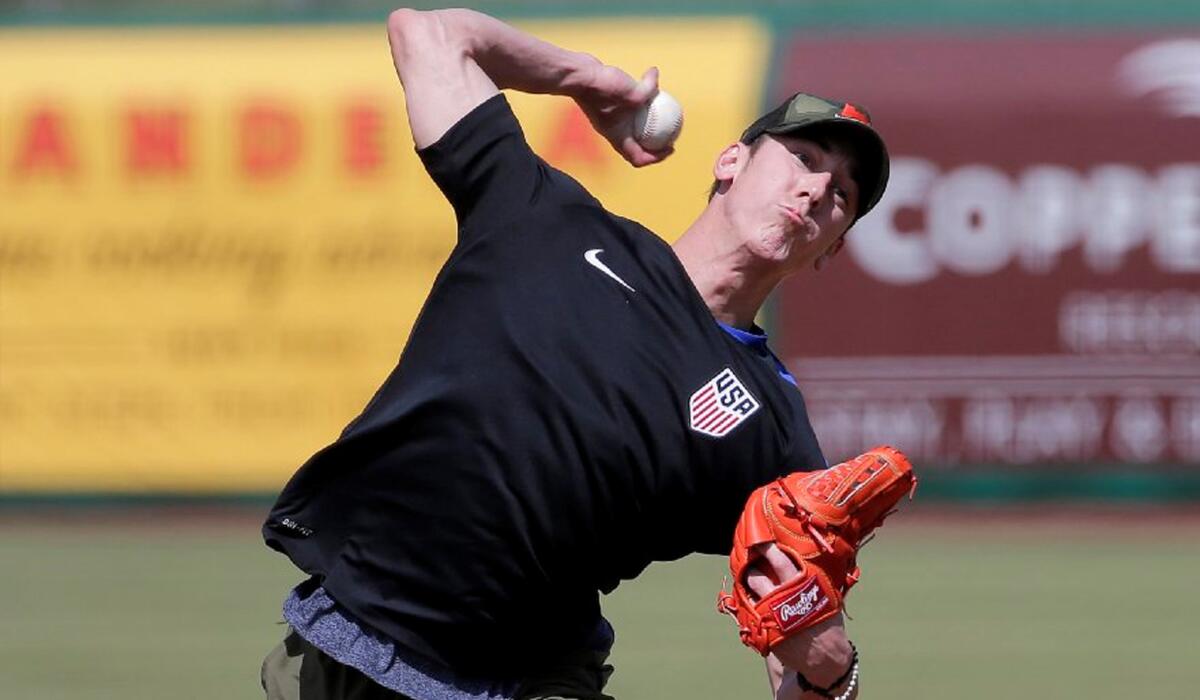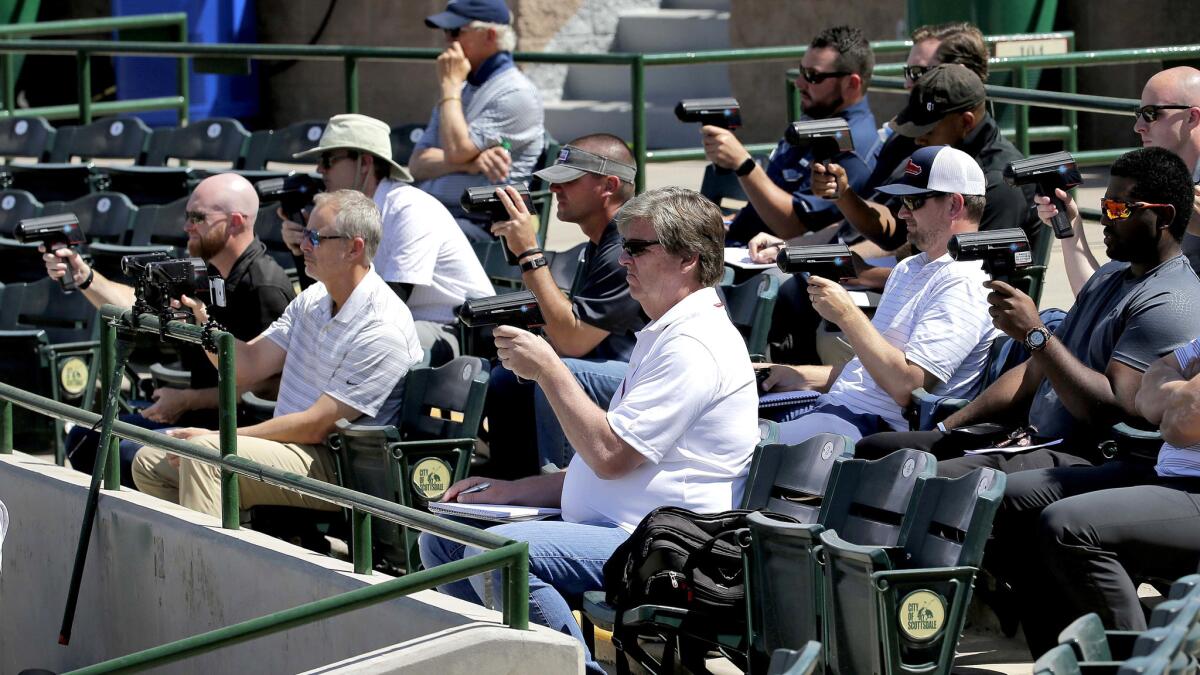His velocity may be down, but Tim Lincecum is on fast track to return to big leagues with Angels

- Share via
Reporting from Tempe, Ariz. — The International Drone Racing Assn. held its North American Cup West championships at Tempe Diablo Stadium on Saturday. A quarter-mile away, forced onto a back field at the Angels’ spring training complex by the high-flying event, Tim Lincecum warmed up for his first game with his new team.
He taught a Venezuelan teenager named Keinner Pina the signs he’d need to use behind the plate. He danced for a few seconds in the outfield, demonstrating something to a coach. And, at exactly 10 a.m., he took the mound, wearing the No. 55 he wore throughout nine seasons with San Francisco.
The former All-Star and two-time Cy Young Award winner faced Mariners minor leaguers for five innings of an extended spring training game, as his father and scouts from at least two teams the Angels will soon face gathered behind the backstop to watch.
“Everything felt pretty good,” Lincecum said. “What I asked for and what the Angels are giving me is just time to move along at my own pace and figure out things that I need to.”
Lincecum threw approximately 75 pitches. Baseball’s standard time frame is not so standard in extended spring training; he notched five outs in the first inning and two outs in the fifth. The adjustments ensured he both reached and did not surpass 15 pitches per inning.
Next, he will start for triple-A Salt Lake on Thursday in Tacoma, Wash., a half-hour from his suburban Seattle hometown. He called that fortuitous timing “surreal.” He has pitched in his home state only once since the Giants selected him 10th in the 2006 draft out of the University of Washington.
The plan calls for him to remain with the Angels’ triple-A affiliate and start on the afternoon of June 7, in Reno, Nev. Then the big leagues beckon. The scheduled date for his major league return is June 12 against Cleveland, which would place his second start on June 18, in Oakland, across the bay from the city where he made his name.

All of this has been dictated by Lincecum. The Angels’ general manager, Billy Eppler, deferred to the 31-year-old right-hander to set his schedule after agreeing earlier this month to pay him $2 million.
“It was kind of different being catered to in that way,” Lincecum said. “Refreshing, in a sense, but different, just because I never knew how to tell myself what I needed. That’s why they’re giving me this time to dictate it. We mapped it out in a conservative mind-set, and hopefully these games get me good.”
During Saturday’s fifth inning, Lincecum tired and lost command. He walked a hitter, and two Mariners minor leaguers whacked doubles to score two runs. Earlier, in the third, Lincecum lost the timing within his lever-driven mechanics, heading toward home too fast without gathering his body in unison. He said he fixed the issue in the fourth.
“I’m just trying to stay and do everything over the mound,” he said. “Those are the things I’m trying to refine and corral as I get closer to a big league game.”
Lincecum said he was not paying particular attention to his fastball velocity. Two radar guns behind home plate clocked him most often at 89 mph. That is a far cry from the 94 he once averaged, but it’s an increase on the 87 he worked with last season.
“I know I’m not going to blow the doors off,” he said. “I already feel pretty confident with what I got. I had to pitch with the stuff that I had the last few years. Now that my velo’s just a couple ticks up from where it was last year, I feel like that can make a huge difference.”
Join the conversation on Facebook >>
From 2012 to 2015, Lincecum averaged 154 innings per season at a 4.68 earned-run average. He averaged 8.4 strikeouts and 3.9 walks per nine innings. From 2007 to 2011, Lincecum averaged 206 innings at a 2.98 ERA. He struck out 9.9 and walked 3.3 per nine innings.
He won the NL Cy Young Award in 2008 and ’09.
Eppler said the Angels are unconcerned about Lincecum’s ERA in recent seasons. The GM implied he was more enticed by the innings he has thrown and his ratio of strikeouts to walks in doing so.
“When you look more into the peripherals, you can capture a little bit of what he’ll be able to bring for us,” Eppler said. “And I think that’ll be impactful.”
Lincecum had September surgery to correct instability within his hip. He said it had long prevented him from completing the sort of corrections he did Saturday.
“Pitching isn’t perfect timing all the time, and you have to be able to work within a couple degrees and percentages,” he said. “That’s what I wasn’t able to do. That’s why I was catapulting myself with my leg, almost whipping myself home with my leg.”
He knew he was out of whack when he fell during his delivery, which he estimated happened about 10 times last season.
“Now that I’m gathering myself over the mound and figuring out how to stay within that world right there and then go, I haven’t dealt with anything like that since,” Lincecum said. “So, that’s a good indication.”
On a conference call with reporters a week ago, Lincecum said he would consider the season a success if he finished it healthy. He said Saturday that was only part of the picture.
“Coming in through this and being apprehensive on it, going through a first-time surgery, it’s hard to break that mental crutch, in a way,” Lincecum said. “Basically, what I’m trying to do is not treat myself as if I’m not healthy. Just go out with no apprehension, 100%, and come out at the end of the year feeling the same way I did going into it. I think that was more of an expectation than a goal.”
Lincecum said he has not watched any baseball this season, reluctant to approach the sport from an altered perspective.
“It’s one thing when you’re watching when you’re a part of it,” he said. “It’s another thing when you’re watching from the outside looking in, trying to get back. And that’s where I found myself.”
Twitter: @pedromoura
ALSO
Mets ask MLB for clarification over Dodgers’ use of laser rangefinder
Big leaguers turn to innovative pregame routines to improve in-game results
Which baseball players provide the least bang for biggest bucks? Josh Hamilton’s right up there
More to Read
Go beyond the scoreboard
Get the latest on L.A.'s teams in the daily Sports Report newsletter.
You may occasionally receive promotional content from the Los Angeles Times.







